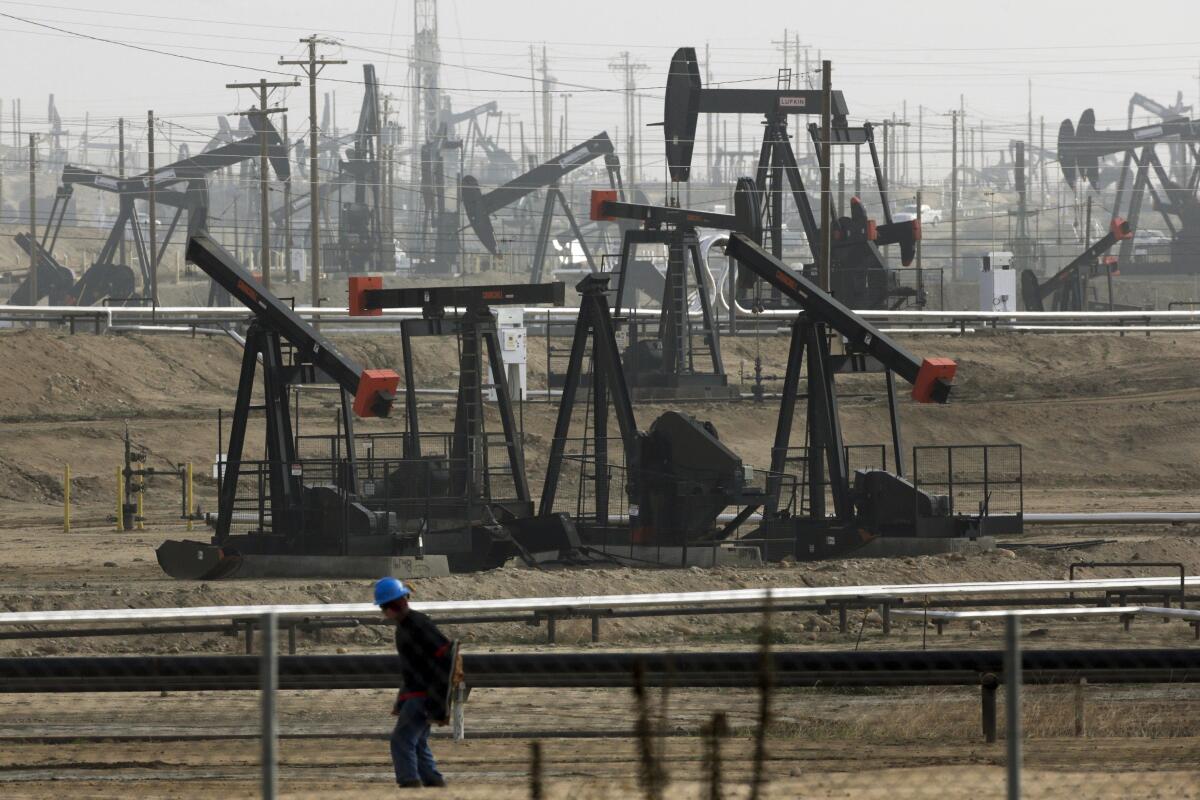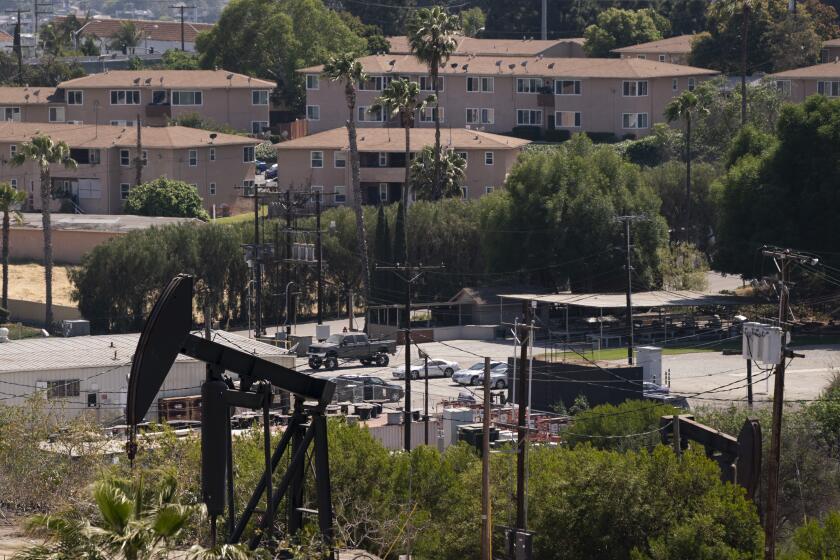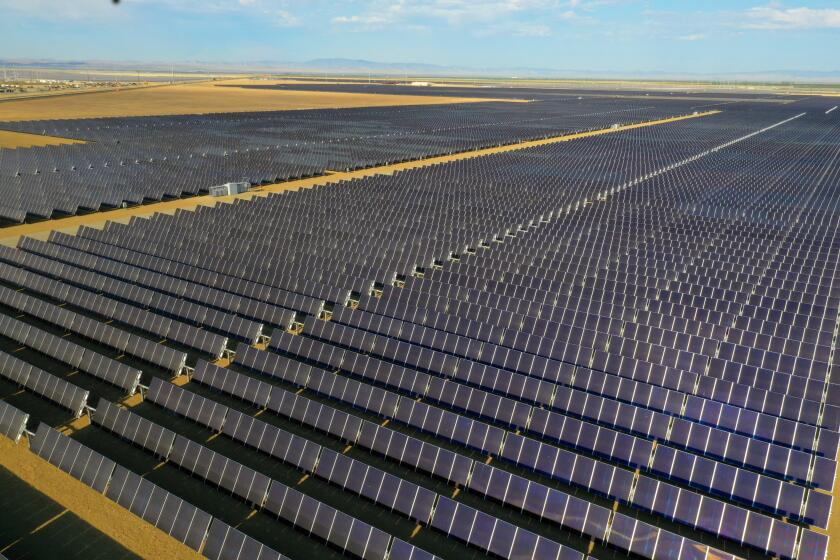Column: Big oil companies are already reneging on their global warming promises

- Share via
If there’s an enduring truism about corporate promises to do well by doing good, it’s that believing them is a mug’s game.
Latest case in point: The promise by some of our largest fossil fuel companies that they would be in the forefront of the transition to renewable energy.
In the last few days, two of the companies that made the most grandiose promises, BP and Shell, have backed away from their pledges about investments in renewable sources such as solar and wind.
We want to continue to go for lower and lower and lower carbon, but it has to be profitable.
— Shell CEO Wael Sawan
On Tuesday, for example, BP Chief Executive Bernard Looney revealed that the company now expects its oil and gas production in 2030 to fall about 25% below what it was in 2019; previously, the company projected a reduction by 40%.
The company also scaled back its projection of emissions from its oil and gas production to a 20% to 30% reduction from 2019 levels by 2030, down from its earlier projection of a 35% to 40% reduction.
Get the latest from Michael Hiltzik
Commentary on economics and more from a Pulitzer Prize winner.
You may occasionally receive promotional content from the Los Angeles Times.
“We need continuing near-term investment into today’s energy system — which depends on oil and gas — to meet today’s demands and to make sure the transition is an orderly one,” Looney said in BP’s strategy update, published Tuesday.
At Shell, renewables advocates were cheered last month by the promotion of Wael Sawan, director of the company’s renewables business, to the CEO post.
Sawan promptly poured cold water on the expectation that Shell would continue to increase its investments in low-carbon fuels, given that the returns on those investments trail those in oil and gas.
Shell’s capital spending on low-carbon energy had risen by about 50% to about $3.5 billion in 2022 from its spending in 2021, up from $172 million in 2017 . But the company said in a media call Feb. 2 that there would be no further increase this year.
“Let me be, I think, categorical in this,” Sawan told investment analysts Feb. 2. “We cannot justify going for a low return. Our shareholders deserve to see us going after strong returns. If we cannot achieve the double-digit returns in a business, we need to question very hard whether we should continue in that business. Absolutely, we want to continue to go for lower and lower and lower carbon, but it has to be profitable.”
BP and Shell were among the companies with the most aggressive renewables projections. Other major oil and gas companies such as Chevron and Exxon Mobil had been much more modest in their expectations.
All four companies, however, had ramped up their rhetorical commitments to the fight against global warming: A study by Japanese researchers published last year found appreciable increases in the use of terms such as “climate change” and “low-carbon energy” in their annual reports from 2009 through 2020.
A new law requires new oil wells to be at least a kilometer away from homes, schools and hospitals. The oil industry will spend millions to overturn it.
The reason that the fossil fuel industry is ratcheting back its commitment to renewables is easy to discern: These investments are anathema to Wall Street.
The very day that BP disclosed its slowdown in renewables investments, its stock rocketed higher by 8.35%. BP and Shell have been trading at much lower price-to-earnings multiples — a common indicator of what Wall Street expects from a company’s future earnings — than Exxon Mobil and Chevron. The p/e ratios are 4.17 and 5.18, respectively, for BP and Shell, and 8.6 and 9.31 for Exxon and Chevron.
It’s tempting to see the transition from oil and gas to wind, solar and other renewable energy sources as dependent on price — and therefore to assume that the declining cost of the renewable sources will allow them to keep gaining on oil and gas in terms of installed capacity.
For the big energy companies, however, it’s profitability, not price, that matters. And their traditional businesses have been spectacularly profitable lately — to the point that it’s become a political scandal. That’s largely because the companies have been notching record or near-record profits while gasoline prices at the pump have soared, driving the worst inflation in decades.
The industry has been accused of gouging motorists. It’s hard to argue with that general conclusion, though it’s harder to pinpoint where in the gasoline system the excess profits are being extracted; regular gas prices in California rose to about $6.43 per gallon in October from about $4.68 at the start of 2022, while crude oil prices fell from a peak of nearly $3 per refined gallon to $2.13.
(In a hilariously stupid riposte in October to President Biden’s public criticism of oil industry profits and demand that the oil companies return some of their gains to American consumers, Exxon Mobil CEO Darren Woods said, “That’s exactly what we’re doing in the form of our quarterly dividend.” Someone might remind Woods that average Americans and Exxon shareholders are not necessarily the same species.)
There’s nothing new in the reluctance of the incumbent energy producers to move into new technologies. History teaches us that when a major technological transition is underway, big legacy companies end up ceding leadership to small, nimble startups.
Russia’s invasion of Ukraine has helped turbocharge the growth of renewables worldwide, but China is leading the flight away from fossil fuels.
That happened at the onset of the personal computer age, when a clutch of brilliant young scientists and engineers employed by Xerox at its Palo Alto Research Center, the legendary PARC, invented the personal computer.
As I’ve chronicled, Xerox’s dependence on its world-beating copier business made it a poor candidate to lead the PC transition. One of the key PARC developers, Larry Tesler, moved to a small company and helped manage the transition from there: Apple. Others went to unheralded new companies such as Atari and Microsoft.
(It’s true that giant IBM did jump into the PC business, but did so at first through a disrespected internal skunk works and embraced the new technology largely after its potential became clear.)
The main reason that fossil fuel companies are reluctant to plunge full-hog into the renewables business has much to do with the fundamentally different economic incentives in those two categories of energy production.
Oil and gas is a highly concentrated industry with high barriers to entry — not everyone can set up as a major integrated fossil fuel company. As a result, the returns on investments are high — 15% or more, in the reckoning of Nick Butler of Kings College, London, a former BP executive.
It’s much easier to enter the solar or wind business, which is fragmented and competitive, and where returns are much lower, typically less than 10%.
Moreover, the payback from fossil fuel investments is consistent and long term. From the standpoint of oil and gas producers, fossil fuel power plants are the gift that keeps giving, as their fuel supplies need constantly to be topped off, Swedish researcher Brett Christophers observed in 2021. For wind and solar installations, the heaviest capital investments are upfront, and the ultimate returns are years into the future.
“It’s comparing apples and oranges,” Christophers told Kate Aronoff of the New Republic. As he explained in his paper, ”Promoting renewables requires considerable resources with very long payback periods for projects with no proven track record.”
When a big corporation decides where to invest, the key metric is return on investment. Under the circumstances, it shouldn’t surprise anyone that Big Oil still sees its traditional products as the key to profits.
Manchin, other fossil fuel shills torpedoed the nomination of banking regulator Sarah Bloom Raskin because she wants to fight climate change
Indeed, it should have been clear to anyone paying close attention to Big Oil’s pledges on renewables investment that they were always hedged.
For instance, Shell’s pledge in its 2019 annual report to reduce the net carbon footprint of its own emissions and those of its customers using its products “by around 20% in 2035 and by around 50% in 2050” carried the qualifier, “assuming society aligns itself with the Paris Agreement’s goals.”
(The Paris agreement of 2015 aimed to limit the rise in mean global temperature to less than 2 degrees Celsius, or 3.6 degrees Fahrenheit, and preferably less than 1.5 degrees C.)
The realities of corporate finance have kept investments in renewable technologies from rising beyond half the level estimated to be needed to meet the Paris goals, according to the International Energy Agency. Of the $1.9 trillion in global energy investment in 2021, the IEA estimated, only about $367 billion was devoted to renewable power. The rest largely went to fossil energy.
The implication of energy finance is that government investment through public subsidies will remain crucial for years, even decades, into the future. That’s what makes the $370 billion in clean energy initiatives in the Biden administration’s Inflation Reduction Act, signed in August, so important — they signal that the U.S. government, at least, is on board.
None of this means that the big fossil fuel companies won’t eventually increase their investments in wind and solar, or recognize that the oil and gas era will come to an end, so their survival depends on transitioning to new technologies.
At the moment, though, the big companies are still hooked on oil and gas. That’s why they’ve been resistant to shareholder demands that they move away from their traditional businesses, and why even the companies that positioned themselves as farsighted avatars of the energy transition are backing down. No one should have taken their promises at face value to begin with.
More to Read
Get the latest from Michael Hiltzik
Commentary on economics and more from a Pulitzer Prize winner.
You may occasionally receive promotional content from the Los Angeles Times.














